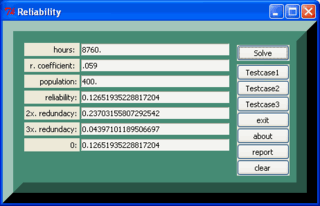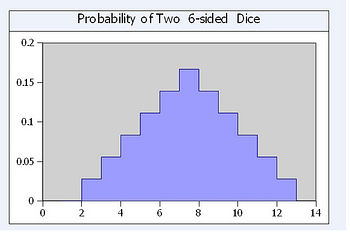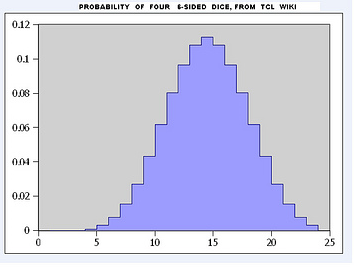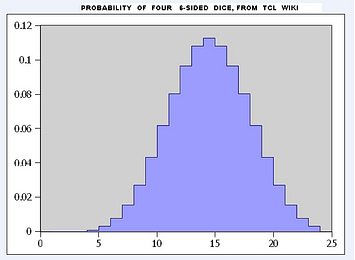Binomial Probability Slot Calculator Example
Binomial Probability Slot Calculator Example
This page is under development. Comments are welcome, but please load any comments in the comments section at the bottom of the page. Please include your wiki MONIKER and date in your comment with the same courtesy that I will give you. Aside from your courtesy, your wiki MONIKER and date as a signature and minimal good faith of any internet post are the rules of this TCL-WIKI. Its very hard to reply reasonably without some background of the correspondent on his WIKI bio page. Thanks, gold 12Dec2018
- Binomial Probability Slot Calculator Example
- Introduction
- Testcase 1
- Testcase 2
- Testcase 3
- Session from console
- Testcase 4
- Testcase 5
- Console session
- Testcase 6
- Testcase 7
- Console session compared to stattrek.com
- Testcase 8
- Extra Credit
- Screenshots Section
- References
- appendix TCL programs
- Console program for two 6-sided dice
- Output for plot
- Console program for two 6-sided dice
- Pseudocode program for two dice
- Pseudocode for finding positions of 7 in sequence
- eTCL program
- Printout for all throws of 3 dice
- Printout for all throws of 4 dice
- Comments Section
Introduction
gold Here is some starter code for Binomial Probability Slot Calculator Example. The impetus for this calculator was checking some iching probabilities on the Chinese Iching Random Weather Predictions. Its easy enough to plug in two formulas into the Slot_Calculator_Demo example. Most of the checked testcases involve flipping two sided objects like coins or popsicle sticks.
In planning any software, it is advisable to gather a number of testcases to check the results of the program. The math for the testcases can be checked by pasting statements in the TCL console. Also, some of the pseudocode statements were checked in the google search engine which will take math expressions. The factorial procedure used below was posted by Suchenworth. Aside from the TCL calculator display, when one presses the report button on the calculator, one will have console show access to the binomial function. and the factorial (fact) function.
For a system of 2 sided sticks or coins of the number N, the probability of getting all zeros or ones would be:
set aa [ expr { (1./(2**$N))} ] ;# generic TCL For three coins, the formula would be 1/(2**3) or 1/8.
set aa [ expr { (1./(2**3)} ] For six coins, the formula would be 1./(2**6) or 1/64
set aa [ expr { (1./(2**6)} ] For N coins, the probability that a one or zero would show up on one of N coins would be
set aa [ expr { (1.-(1./(2**$N)))} ]Testcase 1
The testcase 1 was 6 choose 2. The sample size was 2**6 or 64.
set gg [ expr { 2**6 } ]The probabliity of getting all heads or all tails from 6 coins was 1/(2**6) or 1/64.
set rr [ expr { 1./(2**6) } ]The answer for 6 coins choose 2 was 0.234
Testcase 2
The testcase 2 was 3 choose 2. The sample size was 2**3 or 8.
set kk [ expr { 2**3 } ]The probability of getting all heads or all tails from 3 coins was 1/(2**3) or 1/8.
set jj [ expr { 1./(2**3) } ]The answer for 3 coins choose 2 was 0.375.
Testcase 3
The testcase 3 was 12 choose 2. The sample size was 2**10 or 4096.
set xx [ expr { 2**12 } ]The probabliity of getting all heads or all tails from 12 coins was 1/(2**12) or 1/4096 or 2.441E-4
set vv [ expr { 1./(2**12) } ]The answer for 12 choose 2 was 0.01611.
Session from console
1% set rr [ expr { 1./(2**12) } ]
0.000244140625
2% set gg [ expr { 2**12 } ]
4096
3% set rr [ expr { 1./(2**6) } ]
0.015625
4% set gg [ expr { 2**6 } ]
64Testcase 4
The testcase 4 was 4 coins choose 2. The sample size was 2**4 or 16.
set xx [ expr { 2**4 } ]The probabliity of getting all heads or all tails. from 4 coins was 1/(2**4) or 1/16 or .0625
set vv [ expr { 1./(2**4) } ]The answer for 4 coins choose 2 was 0.375.
Testcase 5
The testcase 5 was 9 coins choose 2. The sample size was 2**9 or 512.
set xx [ expr { 2**9 } ]The probabliity of getting all heads or all tails from 9 coins was 1/(2**9) or 1/512 or .00195
set vv [ expr { 1./(2**9) } ]The answer for 9 coins choose 2 was 0.0703
Console session
1% set xx [ expr { 2**4 } ]
16
2% set vv [ expr { 1./(2**4) } ]
0.0625
3% binom 4 2 2
0.375
4% set xx [ expr { 2**9 } ]
512
5% set vv [ expr { 1./(2**9) } ]
0.001953125
6% binom 9 2 2
0.07031251
% fact 9
362880Testcase 6
The testcase 6 was 20 coins choose 10. The sample size was 2**20 or 1,048,576.
set zz [ expr { 2**20 } ]The probabliity of getting all heads or all tails from 20 coins was 1/(2**20) or 1/1,048,576 or 9.536E-7.
set xx [ expr { 1./(2**20) } ]The answer for 20 coins choose 10 was 0.1762.
Testcase 7
The testcase 7 was 100 coins choose 50. The sample size was 2**100 or 1.26765E+30. google(2 ** 100) = 1.2676506 × 10E30
set zz [ expr { 2**100 } ]The probabliity of getting all heads or all tails from 20 coins was 1/(2**100) or 1/1.26765E+30 or 7.888609E-31. google(1 / (2 ** 100)) = 7.88860905 × 10-31.
set xx [ expr { 1./(2**100) } ]The answer for 100 coins choose 50 was 0.013843748310702326.
Console session compared to stattrek.com
2% binom 100 50 2
0.07978845608028655 stattrek( 0.0795892373871788 )
3% binom 100 60 2
0.010872519679731506 stattrek(0.010843866711638)
4% binom 100 70 2
2.3243440318642605e-5 stattrek( 2.31706905801352E-05 )
5% binom 100 80 2
4.229044215516387e-10 stattrek( 4.22816326760158E-10 )
6% binom 100 90 2
1.3656690823232337e-17 stattrek( 1.36554263874631E-17)
7% binom 100 95 2
5.939398609386625e-23 stattrek( 5.93913811790451E-23)
8% binom 100 99 2
7.888675454251962e-29 stattrek(7.88860905221012E-29) Testcase 8
The testcase 8 was 120 coins choose 50.1.329227E+36. The sample size was 2**120 or 1.329227E+36. google(2 ** 120) = 1.329228 × 10E36
set zz [ expr { 2**120 } ] The probability of getting all heads or all tails from 120 coins was 1/(2**120) or 1/ 1.329227E+36 or 7.5231E-37 google(1 / (2 ** 120)) = 7.52316385 × 10-37
set xx [ expr { 1./(2**120) } ]The answer for 120 coins choose 50 was 0.013843748310702326, omparable to stattrek(0.0138138412069122).
#console session
12% binom 120 50 2
0.013843748310702326 Extra Credit
For a system of one die with kk sides of the number N tosses, the sample size would be:
set aa [ expr { ($kk**$N)} ] For example, a 6 sided die with 2 tosses would have a sample size of 6**2 or 36.
set aa [ expr { ( 6**2 )} ] The probability of two dice having the same face like snake eyes (1:1) on one throw is 1/(sample size) or 1/36.
set pp [ expr { 1./(6**2) } ]The following sums the numbers on two faces. For 2 dice of 6 sides, the probability of a number 7 coming up is 0.1666. In pseudocode statements, the probability of two dice landing with sum 7 would be the number of combinations that add up to seven over the number of all possible combinations from throwing 2 dice. Such a $list can generated in the auxillary eTCL script at the bottom of page.
prob. pseudocode = nom ($list) / denom ( $list) prob. pseudocode = llength [lsearch -all $list 7 ] / [llength $list ] prob. pseudocode = [llength [lsearch -all $list 7 ]] / [llength $list ]
This would find our probability of throw 7 on a one time basis. For the calculator, this process could be generalized into a subroutine that generated a list for 2 to N sides: list(N), an expected dice throw as $facenumber, counted the number of throws showing $facenumber in list(N), and counted all the elements in the list(N).
prob. pseudocode = [llength [lsearch -all $list(N) $facenumber ]] / [llength $list(N) ]
Also, another foreach loop in the list generator could probably generate the possible throws of three dice.
Screenshots Section
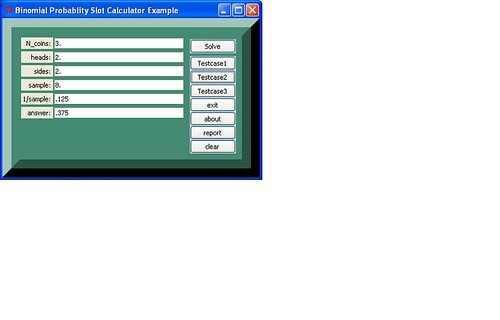
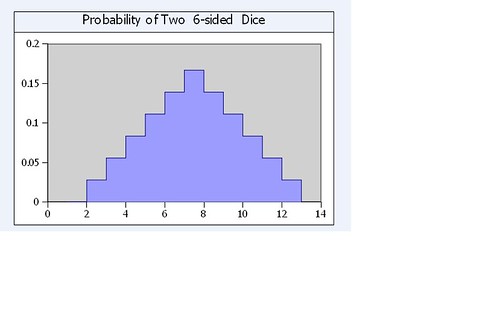
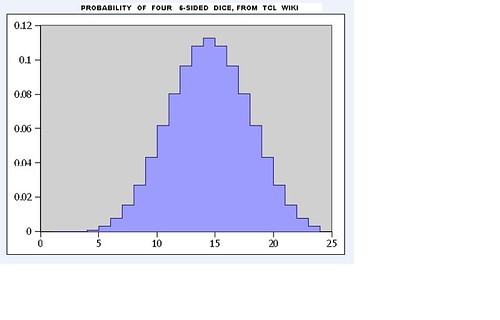
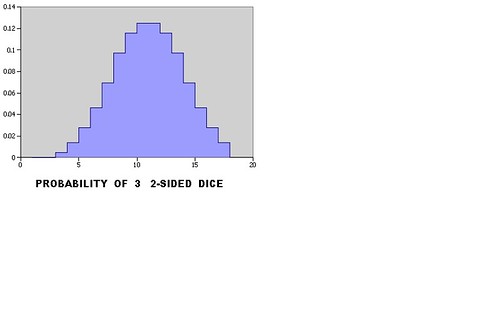


test reload of images from offsite
Screenshots Section
figure 1.
figure 2.
figure 3.
figure 4.
figure 5.
figure 6.
References
- factorial
- Slot_Calculator_Demo
- http://www.knowyourluck.com/coins3u.html (currently 404)
- http://www.learning.com/pdfs/et/activity-35-cointoss.pdf
- http://stattrek.com/Tables/Binomial.aspx Binomial Distribution Calculator
- Sample Math Programs modified [PSE} operation tables to generate throw do-loops
- http://hyperphysics.phy-astr.gsu.edu/hbase/math/dice.html Statistics of Dice Throw
- http://wizardofodds.com/gambling/dice.html Dice Probability basics
- http://www.cobalt.chem.ucalgary.ca/ziegler/educmat/chm386/rudiment/mathbas/probab.htm Probability
- http://gwydir.demon.co.uk/jo/probability/calcinfo.htm Calculating probabilities of throwing two dice
- Math Forum,Date: 05/16/99, Doctor Anthony,Probability dealing with combinations of dice
- Math Forum,Doctor Jeremiah,Probability of dicehttps://wiki.tcl-lang.org/13243
- Google Answers Probability of Coin Flip.mht
- 2 Dice Rolls Probability-Statistics -
- Doctor Math,[L1 ]
appendix TCL programs
Pretty Print Version
# Pretty Print version from autoindent and ased editor
# written on Windows XP on eTCL
# working under TCL version 8.5.6 and eTCL 1.0.1
# gold on TCL WIKI , 21Jul2010
package require Tk
frame .frame -relief flat -bg aquamarine4
pack .frame -side top -fill y -anchor center
set names {{} N_coins: heads: {sides:} {sample:} {1/sample:} {answer:} 1/sample:}
foreach i {1 2 3 4 5 6 } {
label .frame.label$i -text [lindex $names $i] -anchor e
entry .frame.entry$i -width 35 -textvariable side$i
grid .frame.label$i .frame.entry$i -sticky ew -pady 2 -padx 1
}
proc about {} {
set msg "Calculator for binomial probabliity.
from TCL WIKI,
written on eTCL "
tk_messageBox -title "About" -message $msg
}
proc pi {} {expr acos(-1)}
proc fact n {expr {
$n<2? 1:
$n>20? pow($n,$n)*exp(-$n)*sqrt(2*acos(-1)*$n):
wide($n)*[fact [incr n -1]]}
}
proc binomialprobabilty { aa bb cc dd ee } {
#set aa 6
#set bb 4
#set cc 2
set sidex $cc
set aa [ expr { int($aa) } ]
set cc [ expr { int($bb) } ]
set bb [ expr { $aa-$cc } ]
set term1 [ fact $aa ]
set term2 [ fact $bb ]
set term3 [ fact $cc ]
set sample [ expr { $sidex**$aa} ]
set binprob [ expr { ($term1*1.)/($term2*$term3*$sample*1.) } ]
return $binprob ;
}
proc binom { aa bb cc } {
#set aa 6
#set bb 4
#set cc 2
set sidex $cc
set aa [ expr { int($aa) } ]
set cc [ expr { int($bb) } ]
set bb [ expr { ($aa-$cc) } ]
set term1 [ fact $aa ]
set term2 [ fact $bb ]
set term3 [ fact $cc ]
set sample [ expr { $sidex**$aa} ]
set binprob [ expr { ($term1*1.)/($term2*$term3*$sample*1.) } ]
return $binprob ;
}
proc pol { xx1 yy1 xx3 yy3 xx2 } {
return [expr { ((($xx2-$xx1)*($yy3-$yy1))/($xx3-$xx1))+ $yy1 } ] ;}
proc calculate { } {
global answer2
global side1 side2 side3 side4 side5 side6
set answer2 [ binomialprobabilty $side1 $side2 $side3 $side4 $side5 ]
set side4 [ expr { $side3**$side1 } ]
set side5 [ expr { 1./ ($side3**$side1) } ]
set side6 $answer2
set pi5 [pi]
if {$answer2 >= $pi5} { set error5 [expr {100.*$answer2/$pi5-100.}] }
if {$answer2 <= $pi5} { set error5 [expr {100.*$pi5/$answer2-100.}] }
#$x insert 1.0 " % error $error5 "
#$t insert 1.0 " % error $error5 "
}
proc fillup {aa bb cc dd ee ff } {
.frame.entry1 insert 0 "$aa"
.frame.entry2 insert 0 "$bb"
.frame.entry3 insert 0 "$cc"
.frame.entry4 insert 0 "$dd"
.frame.entry5 insert 0 "$ee"
.frame.entry6 insert 0 "$ff "
}
proc clearx {} {
foreach i {1 2 3 4 5 6 } {
.frame.entry$i delete 0 end
}
}
proc reportx {} {
console show;
puts "
The binom function takes
three quantities.
The points are aa,bb ,cc.
The input order of the 3 items
is N_coins heads sides
and solving for binomial probability.
eg. binom 9 2 2 gives 0.0703
"
}
frame .buttons -bg aquamarine4
::ttk::button .calculator -text "Solve" -command { calculate }
::ttk::button .test2 -text "Testcase1" -command { clearx;fillup 6. 2. 2. 64. .0156 .234375 }
::ttk::button .test3 -text "Testcase2" -command { clearx;fillup 3. 2. 2. 8. .125 .375 }
::ttk::button .test4 -text "Testcase3" -command { clearx;fillup 12. 2. 2. 4096. 2.4E-4 .01611 }
::ttk::button .clearallx -text clear -command {clearx }
::ttk::button .about -text about -command about
::ttk::button .cons -text report -command { reportx }
::ttk::button .exit -text exit -command {exit}
pack .calculator -in .buttons -side top -padx 10 -pady 5
pack .clearallx .cons .about .exit .test4 .test3 .test2 -side bottom -in .buttons
grid .frame .buttons -sticky ns -pady {0 10}
. configure -background aquamarine4 -highlightcolor brown -relief raised -border 30
wm title . "Binomial Probablity Slot Calculator Example "*Auxillary programs
Here's searching through a list of thrown dice combos for probability. The worker bee is
[ lsearch -all [ listofnn $nn ] $facen ] $facen is the sum of a 2-dice throw like 7. $nn is the number of sides,eg 6.
Subroutine is invoked by a foreach procedure for probability, which would be number of thrown 7's over all possible throws. Drop (-all) and lose all, returning only one position of "7" in list.
Console program for two 6-sided dice
# prob. subroutines for two 6-sided dice
# throw of 7 etc.
proc listofnn { nn } {
set lister [list ]
for { set i 1 } { $i <= $nn } { incr i } {
lappend lister $i
}
set i 0
while { [ incr i ] <= $nn } {
foreach item $lister {
append listofnn " [ expr {$item+$i} ]"
}
}
return $listofnn
}
proc calculation { nn facen } {
set ee [llength [ listofnn $nn ]]
set kk [ llength [ lsearch -all [ listofnn $nn ] $facen ] ]
set prob [ expr { ($kk*1.) / $ee } ]
return $prob
}
console show
set limit 12
for { set i 1 } { $i <= $limit } { incr i } {
lappend listxxx $i
lappend listxxx [ calculation 6 $i ]
puts " $i [ calculation 6 $i ] "
}
puts $listxxxOutput for plot
output plotted in jpg above
1 0.0
2 0.027777777777777776
3 0.05555555555555555
4 0.08333333333333333
5 0.1111111111111111
6 0.1388888888888889
7 0.16666666666666666
8 0.1388888888888889
9 0.1111111111111111
10 0.08333333333333333
11 0.05555555555555555
12 0.027777777777777776
#endConsole program for two 6-sided dice
# written on Windowws XP on eTCL
# working under TCL version 8.5.6 and eTCL 1.0.1
# gold on TCL WIKI , 21Jul2010
# find probability of 7 on 2 6-sided dice.
proc listofnn { nn } {
set lister [list ]
for { set i 1 } { $i <= $nn } { incr i } {
lappend lister $i
}
set i 0
#puts $lister
while { [ incr i ] <= $nn } {
foreach item $lister {
append listofnn " [ expr {$item+$i} ]"
}
}
return $listofnn
}Pseudocode program for two dice
console show
#not efficient code here.
#trying to show evolution
#from pseudocode
puts " prob. pseudocode = nom (\$list) \/ denom ( \$list) "
puts "pseudocode:find all possible combinations from throwing 2 dice"
puts [ listofnn 6 ]
puts "pseudocode: find length of list"
puts "pseudocode:\[llength \$list \]"
puts [llength [ listofnn 6 ]]
set ee [llength [ listofnn 6 ]]
puts "pseudocode: find positions of 7 in list"
puts "prob. pseudocode \= \[lsearch -all \$list 7 \] "
puts [ lsearch -all [ listofnn 6 ] 7 ]
puts "pseudocode: count number of throws of 7"
puts " prob. pseudocode \= llength \[lsearch -all \$list 7 \] "
puts [ llength [ lsearch -all [ listofnn 6 ] 7 ] ]
set kk [ llength [ lsearch -all [ listofnn 6 ] 7 ] ]
puts "prob. pseudocode = \[llength \[lsearch -all \$list 7 \]\] \/ \[llength \$list \]"
#not efficient code here.
#trying to show evolution
#from pseudocode
set prob [ expr { ($kk*1.) / $ee } ]
puts $prob
#end of deckPseudocode for finding positions of 7 in sequence
printed output of deck prob. pseudocode = nom ($list) / denom ( $list) pseudocode:find all possible combinations from throwing 2 dice 2 3 4 5 6 7 3 4 5 6 7 8 4 5 6 7 8 9 5 6 7 8 9 10 6 7 8 9 10 11 7 8 9 10 11 12 pseudocode: find length of list pseudocode:[llength $list ] 36 pseudocode: find positions of 7 in list prob. pseudocode = [lsearch -all $list 7 ] 5 10 15 20 25 30 pseudocode: count number of throws of 7 prob. pseudocode = llength [lsearch -all $list 7 ] 6 prob. pseudocode = [llength [lsearch -all $list 7 ]] / [llength $list ] 0.16666666666666666
eTCL program
# written on Windowws XP on eTCL
# working under TCL version 8.5.6 and eTCL 1.0.1
# gold on TCL WIKI , 21Jul2010
frame .frame -relief flat -bg aquamarine4
pack .frame -side top -fill y -anchor center
set names {{} {throw:} {N_sides:} {No_dice:} {sample:} {1/sample:} {answer:} 1/sample:}
foreach i {1 2 3 4 5 6 } {
label .frame.label$i -text [lindex $names $i] -anchor e
entry .frame.entry$i -width 35 -textvariable side$i
grid .frame.label$i .frame.entry$i -sticky ew -pady 2 -padx 1
}
proc about {} {
set msg "Calculator for Probablity N-sided Double Dice.
from TCL WIKI,
written on eTCL "
tk_messageBox -title "About" -message $msg
}
proc pi {} {expr acos(-1)}
proc fact n {expr {
$n<2? 1:
$n>20? pow($n,$n)*exp(-$n)*sqrt(2*acos(-1)*$n):
wide($n)*[fact [incr n -1]]}
}
proc listofnn { nn } {
# prob. subroutines for two 6-sided dice
# throw of 7 etc.
for { set i 1 } { $i <= $nn } { incr i } {
lappend lister $i
}
set i 0
while { [ incr i ] <= $nn } {
foreach item $lister {
append listofnn " [ expr {$item+$i} ]"
}
}
return $listofnn
}
proc dice { facen nn } {
# prob. subroutines for two 6-sided dice
# throw of 7 etc.
set facen [ expr { int($facen) } ]
set nn [ expr { int($nn) } ]
set ee [llength [ listofnn $nn ]]
set kk [ llength [ lsearch -all [ listofnn $nn ] $facen ] ]
set prob [ expr { ($kk*1.) / ($ee*1.) } ]
return $prob
}
proc binom { aa bb cc } {
#set aa 6
#set bb 4
#set cc 2
set sidex $cc
set aa [ expr { int($aa) } ]
set cc [ expr { int($bb) } ]
set bb [ expr { ($aa-$cc) } ]
set term1 [ fact $aa ]
set term2 [ fact $bb ]
set term3 [ fact $cc ]
set sample [ expr { $sidex**$aa} ]
set binprob [ expr { ($term1*1.)/($term2*$term3*$sample*1.) } ]
return $binprob ;
}
proc pol { xx1 yy1 xx3 yy3 xx2 } {
return [expr { ((($xx2-$xx1)*($yy3-$yy1))/($xx3-$xx1))+ $yy1 } ] ;}
proc calculate { } {
global colorwarning
global colorback
global answer2 answer3
global side1 side2 side3 side4 side5 side6
set answer2 ""
set side3 [ expr { int($side3) } ]
set answer2 [dice $side1 $side2 ]
set side4 [ expr { $side2**$side3 } ]
set side5 [ expr { 1./ ($side2**$side3) } ]
set side6 $answer2
set pi5 [pi]
if {$answer2 >= $pi5} { set error5 [expr {100.*$answer2/$pi5-100.}] }
if {$answer2 <= $pi5} { set error5 [expr {100.*$pi5/$answer2-100.}] }
#$x insert 1.0 " % error $error5 "
#$t insert 1.0 " % error $error5 "
}
proc fillup {aa bb cc dd ee ff } {
.frame.entry1 insert 0 "$aa"
.frame.entry2 insert 0 "$bb"
.frame.entry3 insert 0 "$cc"
.frame.entry4 insert 0 "$dd"
.frame.entry5 insert 0 "$ee"
.frame.entry6 insert 0 "$ff "
}
proc clearx {} {
foreach i {1 2 3 4 5 6 } {
.frame.entry$i delete 0 end
}
}
proc reportx {} {
console show;
puts "
The interpolation function takes
two know points on a line and
solves for an intermediate point.
The points are xx1,yy1,xx2,yy2 and xx3,?yy3?
The interpolation function loaded as
proc pol. User should be able
to cut and paste (c&p)
pol 50. 1000. 200. 1200. 150.
and save answer (1133.3) on console.
********
The binom function takes
three quantities.
The input order of the 3 items
is N_coins heads sides.
and solving for binomial probability.
eg. (c&p) binom 9 2 2 gives 0.0703
*********
The listofnn function
returns a list of combos for
N_sides double dice.
Max combo should be twice N_sides.
eg. (c&p) listofnn 6 gives 36 combos
************
The dice function takes
two quantities.
The input order of the 2 items
is throw N_sides.
eg.(c&p) dice 7 6 gives 0.166
"
}
frame .buttons -bg aquamarine4
::ttk::button .calculator -text "Solve" -command { calculate }
::ttk::button .test2 -text "Testcase1" -command { clearx;fillup 7. 6. 2. 36. .0277 .166 }
::ttk::button .test3 -text "Testcase2" -command { clearx;fillup 3. 6. 2. 36. .0277 .0555 }
::ttk::button .test4 -text "Testcase3" -command { clearx;fillup 2. 6. 2. 36. .0277 .0277 }
::ttk::button .clearallx -text clear -command {clearx }
::ttk::button .about -text about -command about
::ttk::button .cons -text report -command { reportx }
::ttk::button .exit -text exit -command {exit}
pack .calculator -in .buttons -side top -padx 10 -pady 5
pack .clearallx .cons .about .exit .test4 .test3 .test2 -side bottom -in .buttons
grid .frame .buttons -sticky ns -pady {0 10}
. configure -background aquamarine4 -highlightcolor brown -relief raised -border 30
bind . <Motion> {wm title . "Probablity N-sided Double Dice Slot Calculator Example "}The testcase 4a was 3 dice rolling all ones. The sample size was 6**3 or 216.
set zz [ expr { 6**3 } ]The probability of getting all ones from 3 dice was 1/(6**3) or 0.0046296.
set xx [ expr { 1./(6**3) } ]Printout for all throws of 3 dice
printout for all throws of 3 dice. set tcl_precision 17 was not used here, but I can't tell much difference.
1 0.0 2 0.0 3 0.004629629629629629 4 0.013888888888888888 5 0.027777777777777776 6 0.046296296296296294 7 0.06944444444444445 8 0.09722222222222222 9 0.11574074074074074 10 0.125 11 0.125 12 0.11574074074074074 13 0.09722222222222222 14 0.06944444444444445 15 0.046296296296296294 16 0.027777777777777776 17 0.013888888888888888 18 0.004629629629629629 #end
Printout for all throws of 4 dice
all throws of 4 dice set tcl_precision 17 (on)
1 0.0 2 0.0 3 0.0 4 0.0007716049382716049 5 0.0030864197530864196 6 0.007716049382716049 7 0.015432098765432098 8 0.027006172839506171 9 0.043209876543209874 10 0.061728395061728392 11 0.080246913580246909 12 0.096450617283950615 13 0.10802469135802469 14 0.11265432098765432 15 0.10802469135802469 16 0.096450617283950615 17 0.080246913580246909 18 0.061728395061728392 19 0.043209876543209874 20 0.027006172839506171 21 0.015432098765432098 22 0.007716049382716049 23 0.0030864197530864196 24 0.0007716049382716049 end
The testcase 5a was 5 dice rolling all sixes. The sample size was 6**5 or 7776.
set zz [ expr { 6**5 } ]The probabliity of getting all sixes from 5 coins was 1/(6**5) or 1.28E-4
set xx [ expr { 1./(6**5) } ]Comments Section
Please place any comments here, Thanks.
| Category Numerical Analysis | Category Toys | Category Calculator | Category Mathematics | Category Example | Toys and Games | Category Games | Category Application | Category GUI |
